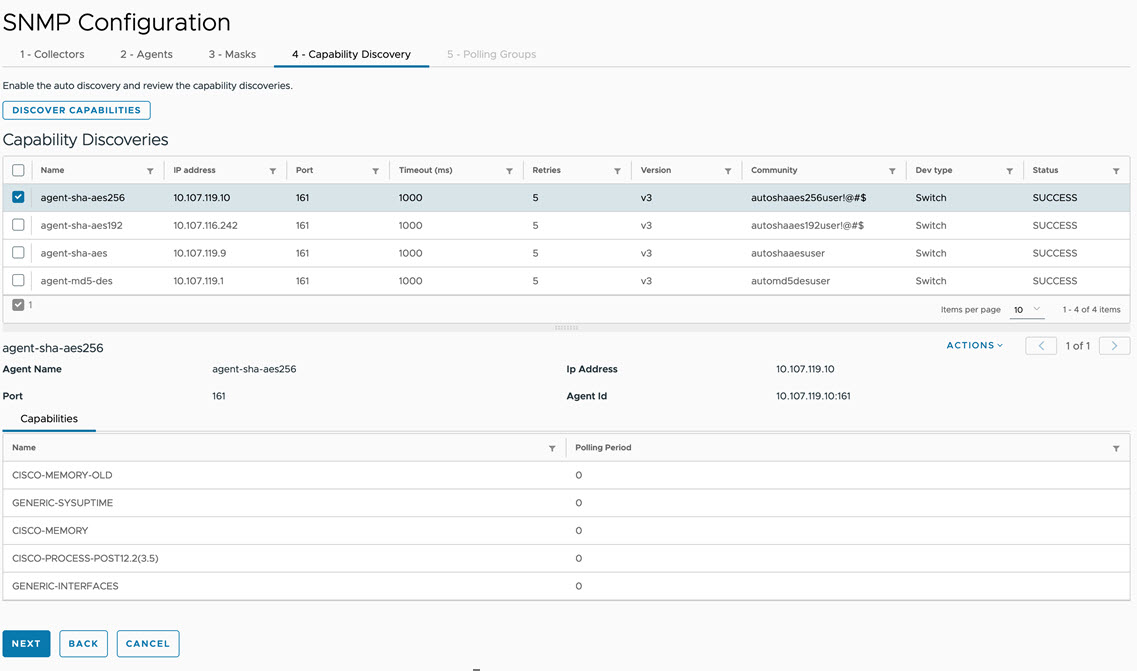You can choose to discover capabilities on the agents uploaded. This step performs two functions - Discovers capabilities on the uploaded agents and Generates polling groups for the discovered agents. This step can be skipped and polling groups can be added manually.
Procedure
- In Capability Discovery tab, click Discover Capabilities to perform discovery in the following ways:
If no agent is selected, discovery is performed on all agents added.
If agents are selected, discovery is performed only on those selected agents.

- Select any discovered agent to view the discovered capabilities.
- Click Actions > Edit Capabilities, to edit the capabilities of the selected agent.
- Click Save > Next.
Note: The capability is the same as an SNMP Mask. Discovering a capability on an agent means to identify the masks that are applicable to the agent. Having discovered relevant masks for an agent, polling groups are generated by grouping agents with the same masks.
The discovery is performed on all the agents using all the masks.
Device Distribution Logic: The device distribution logic is based on the distribution factor specified for each collector.
The agents are distributed to existing collectors in the following:
Grouping Agents: The agents uploaded are grouped based on the following attributes:- collectorNameList - Agents with the same collectorNameList are grouped together.
- capabilitiesList - Agents with the same set of capabilities are grouped together Based on these two parameters groups of agents are formed
Distributing agent groups to collectors: A group of agents are distributed to a particular collector based on the rules :- The collector name must match one of the group's collectorName attributes, if some are provided. This condition is always satisfied when the group does not have a collectorName attribute.
- The collector must support every one of the specified group's capabilities Based on the group's compatibility with the collector using the above two checks, a fixed number of agents from the current group are assigned to the current collector. The number of agents assigned from the current group is subject to the distributionFactor of the current collector and other compatible collectors for the current group.
As an example, let’s suppose that 500 devices are imported and 4 collectors are available. Available collectors:- Collector A: distribution-factor = 10, capabilities: interface*, ipsla, qos
- Collector B: distribution-factor = 20, capabilities: interface*, qos
- Collector C: distribution-factor = 30, capabilities: interface*, ipsla, qos
- Collector D: distribution-factor = 40, capabilities: interface*, ipsla Imported
Devices:- Group 1: 100 Devices, capabilities: qos
- Group 2: 100 Devices, no capability, collectorName = Collector A, collectorName = Collector D
- Group 3: 100 Devices, capabilities: ipsla, qos
- Group 4: 100 Devices, capabilities: ipsla • Group 5: 100 Devices, capabilities: ipsla, collectorName = Collector B
The distribution algorithm result must be similar to this:- Collector A: 17(1) + 20(2) + 25(3) + 13(4) = 75
- Collector B: 33(1) • Collector C: 50(1) + 75(3) + 37(4) = 162
- Collector D: 80(2) + 50(4) = 130
The 100 remaining devices could not be distributed because they did not match any of the collectors (conflicting criteria: Collector B does not support the ipsla capability).
What to do next
Add the polling group details.